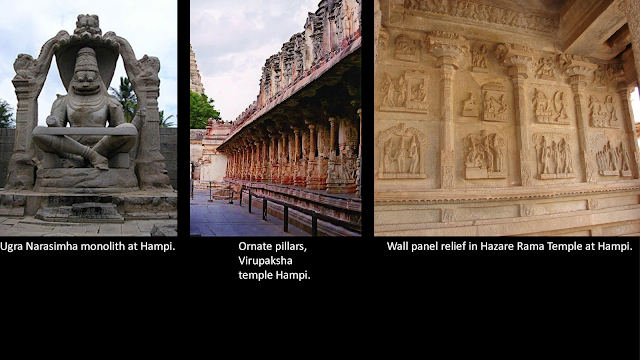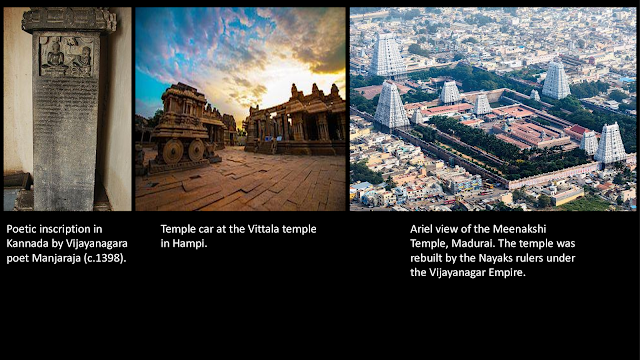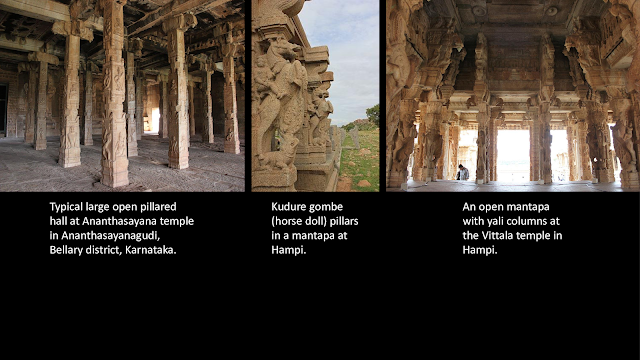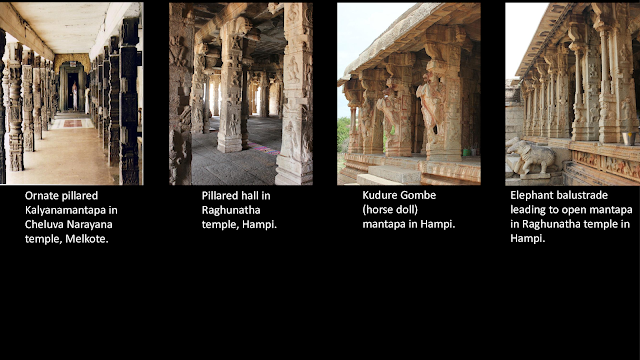Vijayanagara Empire
Vijayanagara Empire
Sangama dynasty
Harihara I 1336–1356
Bukka Raya I 1356–1377
Harihara Raya II 1377–1404
Virupaksha Raya 1404–1405
Bukka Raya II 1405–1406
Deva Raya I 1406–1422
Ramachandra Raya 1422
Vira Vijaya Bukka Raya 1422–1424
Deva Raya II 1424–1446
Mallikarjuna Raya 1446–1465
Virupaksha Raya II 1465–1485
Praudha Raya 1485
Saluva dynasty
Saluva Narasimha Deva Raya 1485–1491
Thimma Bhupala 1491
Narasimha Raya II 1491–1505
Tuluva dynasty
Tuluva Narasa Nayaka 1491–1503
Vira Narasimha Raya 1503–1509
Krishna Deva Raya 1509–1529
Achyuta Deva Raya 1529–1542
Venkata I 1542
Sadasiva Raya 1542–1570
Aravidu dynasty
Aliya Rama Raya 1542–1565
Tirumala Deva Raya 1565–1572
Sriranga I 1572–1586
Venkata II 1586–1614
Sriranga II 1614
Rama Deva Raya 1617–1632
Venkata III 1632–1642
Sriranga III 1642–1646
Capital Vijayanagara, Penukonda, Chandragiri, Vellore
Common languages Kannada, Telugu, Sanskrit
Religion Hinduism
Government Monarchy
Currency Varaha
King
• 1336–1356 Harihara I
• 1642–1646 Sriranga III
History
• Established 1336
• Earliest records 1343
• Disestablished 1646
Preceded by
Hoysala Empire
Kakatiya dynasty
Kampili kingdom
Madurai Sultanate
Pandyan dynasty
Musunuri Nayaks
Reddy dynasty
Succeeded by
Kingdom of Mysore
Nayakas of Keladi
Thanjavur Nayak kingdom
Madurai Nayak dynasty
Nayakas of Chitradurga
Adil Shahi dynasty
Qutb Shahi dynasty
Nayaks of Gingee
Today, it is a part of India.
Introduction:
- The Vijayanagara kings patronized architecture, art and fine arts.
- It is rare to find such political hegemony that extended for 3 centuries.
- (Note – hegemony – leadership or dominance, especially by one state or social group over others.)
- Vijayanagara empire stands as a rare example of such an endeavour.
- It served as a barrier to Muslim invasions.
- It is believed that the Vijayanagara Empire was established to protect and promote the Hindu culture and religion.
- In South Indian history, the history of the Vijayanagara Empire stands as the last glorious episode.
Brief Political History:
- Vijayanagara was one of the kingdoms that declared independence during Muhammad-bin-Tughlaq’s reign.
- Harihara and Bukka Raya were the founders of the Vijayanagara Empire.
- With the blessings of Vidyaranya, Vidyanagara, the present Hampi was established on the southern bank of river Tungabhadra in 1336 A.D. which later became famous as Vijayanagara in the history of South India.
- The Vijayanagara Empire was ruled by 4 dynasties; Sangama, Saluva, Tuluva and Aravidu.
Sangama dynasty (1336-1485 A.D.):
- This is the first dynasty that ruled the Vijayanagara kingdom.
- Sangama was the father of Harihara and Bukka Raya and hence this dynasty was named after him.
- It ruled for one and a half century.
- The empire extended from the river Krishna in the north to River Kaveri in the south; the Arabian Sea in the west to Bay of Bengal in the east.
- Harihara annexed the Hoysala territories and thus extended the kingdom.
- Devaraya II, known as Praudha Devaraya was a powerful personality in the Sangam lineage.
- He had interest in literature and was a great patron of dramas and Vritti-compositions (A style of dramatic composition).
- Chamarasa was his court poet. He was a Virashaiva poet in the Kannada language.
- The Telugu poet Srinatha of Kondaveedu defeated the Sanskrit poet Dindima and hence received the felicitation, `Kanakabhisekaram' from Praudha Devaraya.
- (Note – felicitations – words expressing praise for an achievement or good wishes on a special occasion.)
- During his reign in Hampi, the Vittalaswamy temple was built.
- The rule of Sangama dynasty began to deteriorate after him and it came to an end when Saluva Narasimha of Penukonda defeated the last Sangam king, Virupaksha and thus the rule of Saluva lineage began.
Saluva Dynasty (1486-1505 A.D.):
- Saluva Narasimha, the founder of Saluva dynasty was one of the successors of Mangu.
- He served the Vijayanagara rulers as chieftain and ultimately ascended the throne of Vijayanagara.
- He faced many revolts with strength and vigour, hence was able to put down all of them and ruled up to 1490 A.D.
- Soon after him, his minister Tuluva Narasa Nayaka brought Saluva Thimma to the throne.
- After Thimma, Narasimha Raya II became king but he was a weak ruler.
- Hence, Tuluva Narasa Nayaka ascended the throne but he died within a short period of time after becoming the king.
- Tuluva Vira Narasimha Raya became the next king and thus the rule of Tuluva dynasty began.
Tuluva Dynasty (1505-1576 A.D.):
- Tulunadu, part of Mysore, was the original home of Tuluvas and so their dynasty was named after this place.
- Tuluva Narasa Nayaka was its founder, but the inception of this lineage started with Narasimha Raya, who ruled from 1505 to 1509 A.D.
- His brother Srikrishna Deva Raya's reign is considered one of the most important and glorious periods, not only in the history of the Vijayanagara kingdom, but also during the reign of Tuluva dynasty.
- He was a versatile genius and made this mark as a great warrior too.
- He was an able administrator, an excellent politician, liberal patron of art and was fond of Sanskrit and other languages such as Telugu, Kannada, etc.
- Saluva Timmarusu was his prime minister.
- He waged war against Bahmani kingdom and annexed Raichur and Mudgal areas, as the Bahmani Sultanate was already disintegrated into five independent kingdoms namely Bidar, Bijapur, Ahmadnagar, Golkonda and Berar.
- In 1510 A.D., he invaded Bidar, went up to Gulbarga, freed Sultan Mahmud Shah and made him ascend the throne of Bidar.
- Thus, he assumed the title "Yavanaraja Sthapanacharya".
- In 1523 A.D., he declared war on Bijapur, annexed Bijapur and Gulbarga, went up to Sagar and looted all the regions.
- Finally, the Bahmani Sultanate had to recognize his hegemony.
- However, the last days of his life were not happy due to the turn of events like the death of his young son, Tirumala Raya.
- After that he nominated his half-brother Achuyta as his successor and died by the end of 1529 A.D.
Aravidu Dynasty:
- Aravidu dynasty was founded by Tirumala Deva Raya, the younger brother of Aliya Rama Raya.
- He ruled his empire from Penugonda.
- In this dynasty, Venkatapati Raya II was a notable person.
- The Vijayanagara empire collapsed in 1614, and the final remains ended in 1646, from continued wars with the Bijapur sultanate and others.
Administration System:
- Sri Krishna Deva Raya was also a good administrator.
- He reorganized the administrative system with the help of his minister Saluva Timmarusu, popularly known as Appaji.
- Agriculture and trade were encouraged.
- Irrigation tanks were constructed and canals were dug to provide water for agricultural operations.
- A big tank was constructed at Nagalapuram.
- The accounts of Nuniz and Domingo Paes testify to the imperial greatness of the city and the wealth and luxury of the people.
- During his time, the annual festival 'Vasanthotsavam' was celebrated in a big way.
- He was not only a great warrior and administrator, but also a patron of literature and hence had the title "Sahitya Sangita Samarangana Sarvabhouma".
- His court was known as 'Bhuvanavijayam' and consisted of 8 great poets known as 'Ashtadiggajas'.
- Their contributions in Sanskrit, Telugu, Tamil and Kannada were marvellous.
- Krishna Deva Raya was the follower of Vaishnavism and Vyasatirtha, the great Dvaita saint from Mysore belonging to the Madhwa order, was his Rajaguru.
- This has influenced Krishna Deva Raya to build Krishna temple and Hazara Rama temple.
- His also added gopuras and mandapas to the temples at Kanchi, Simhachalam, Tirupati, Kalahasti and Ahobilam.
- The Portuguese traveller Domingo Paes visited the Vijayanagara capital in 1520-22 A.D.
- Paes reported advanced irrigation technology that allowed the kingdom to produce high yields of crops at very reasonable prices, and a wide variety of cultures. He described a busy market of precious stones. The city was prospering and its size was comparable to Rome, with abundant vegetation, aqueducts and artificial lakes.
Economic Conditions:
- The foreign visitors Domingo Paes, Abdul Razzaq and Nuniz described the glory and economic excellence of the Vijayanagara empire.
- The periodic invasions of Bahmani Sultans against Vijayanagara were because of its wealth, prosperity and splendour.
- The Portuguese pilgrim stated that Sri Krishna Deva Raya used to preserve one lakh coins from his annual income after spending for his army and other royal expenses.
- The economic condition of the empire was sound, but the common people's economic situation was disappointing.
- In order to improve the economic conditions of the kingdom through agricultural development, forest areas were cleared and several thousands of waste lands were brought under cultivation.
- Bukka Raya II built a dam across the river Tungabhadra, which facilitated the growth of flower and fruit gardens around the capital city and hence kingdom's income increased tremendously.
- Projects for the construction of tanks, canals and wells were taken up on a large scale.
- According to Abdul Razzaq, much of the empire was fertile and well cultivated.
- Most of the growers were tenant farmers and were given the right of part ownership of the land over time.
- Tax policies encouraging essential produce made distinctions between the different ways in which the land was being put to use to determine how the tax was levied.
- Both men and women worked in the agricultural fields and the landless agricultural labourers were employed on remuneration basis but some others led their life as agricultural slaves.
- The entire Vijayanagara kingdom was provided with enormous irrigational facilities.
- These developmental activities, throughout the country, increased the crop production along with the establishment of fruit gardens of guava, lemon, mango, sugarcane and coconut, which gave the farmers an opportunity to earn good profits.
- Food grains like jowar, paddy, ragi, greengram, blackgram, bengalgram and oil seeds like Castor and linseed were produced on a large scale.
- Production of sugar, oils, indigo and coconut was also taken up on a large scale.
- According to some sources, Adoni, Tadipatri, Gooty and Vinukonda were centres for cotton textile and at Alvakonda village alone there were 411 looms.
- Dyeing industry was connected to the textile industry.
- During the reign of the Vijayanagara empire, 'Kalamkari' clothes had a good demand from foreign countries.
- Abdul Razak mentioned the existence of 300 sea ports in the Vijayanagara empire and Calicut was an important sea port in those days.
- Tax on foreign trade was also one of the major sources of income during this period in time.
- The imports were mainly meant to provide the important essentials for battlefields like horses, guns and cannons.
- The artisans who made handicrafts and small-scale industries established guilds and got their businesses regularized.
- The economic strength and power of such commercial guilds can be estimated through the donations and gifts given to temples by them.
Social Conditions:
- The Vijayanagara society possessed Ashtadasha castes and caste feeling increased during this period.
- Agraharas were exempt from paying taxes as they had been given to the Brahmanas as well as their students to pay patronage to them.
- As the Vijayanagara rulers followed religious tolerance, there was religious harmony in the society.
- The society was divided into several castes and sub-castes.
- Vijayanagar society was stratified and hierarchal with four castes: Brahmins, Rachavaru, Vaishyas, and Sudras.
- The Vokkaligas, the Reddis and Vellalas were the main agricultural communities.
- Devadasi system was a social custom prevalent in those days.
- (Note - In Southern India, a devadasi was a female artist who was dedicated to worship and serve a deity or a temple for the rest of her life. The dedication took place in a Pottukattu ceremony that was somewhat similar to a marriage ceremony. In addition to taking care of the temple and performing rituals, these women also learned and practiced classical Indian artistic traditions such as Bharatanatyam, Mohiniyattam, Kuchipudi, and Odissi. Their social status was high as dance and music were an essential part of temple worship.)
- Heavy taxes, social evils and invasions made the life of poor people miserable.
- The economic differences among the people resulted in clashes between them. This might have contributed a lot to the downfall of the Vijayanagara empire.
Religious conditions:
- Vijayanagara empire was established to protect the Hindu religion and culture.
- Advaita, Visistadvaita Siddhanthas, Saiva-Vaishnava religions had wide propagation in the Vijayanagara period.
- Saivism and Vaishnavism were the two predominant religions of the empire, but the followers of Jainism also existed during the period.
- They showed tolerance towards other religions.
- Though the Vijayanagara rulers exhibited tolerance towards all religions that were prevalent during their reign, they showed more affection towards Kalamukha sect as they had more faith in Vedic rituals.
- In the Kannada region of the Vijayanagara empire, Veera Saivism became popular among the people.
- Animal sacrifices were prevalent.
- The followers of Ramanujacharya were divided into Vadakalai and Thenkalai classes.
- Vallabhacharya was a contemporary of Krishna Deva Raya.
- Haridasa propagated the Madhvaita principles in the Kannada regions.
- Saluva and Tuluva dynasties patronized Vaishnavism.
- The people of Vijayanagara empire actively took part in the religious and cultural way of life.
- Simhachalam temple located in the northern part and Tirupati and Ahobilam temples located in the southern part of Praudha Raya’s empire were revered.
- The grand celebration of the 9 days festival known as `Maharnavami’ was observed by the Vijayanagara rulers.
- Nicolo Conti described the `Vasanthostava' in his writings.
- Lord Venkateshwara temple in Tirupati was one of the famous temples of South India during those days.
- The importance of this temple was due to the liberal grants issued by the kings of the empire and hence it became a famous pilgrim centre.
- Venkatapathi Raya II issued permission for the construction of churches at Chandragiri and Vellore.
- The Royalty went to pilgrimages on horses and palanquins, whereas the common people went on foot.
- Because of the religious tolerance observed by the Vijayanagara rulers, a harmonious relationship existed between the Muslims and the Hindus.
Education and Literature:
- Kanchi, Madurai and Vijayanagara were the important centres of learning.
- Agraharas and monasteries were the famous centres of teaching.
- (Note - An Agraharam or Agrahara was a grant of land and royal income from it, typically by a king or a noble family in India, for religious purposes, particularly to Brahmins to maintain temples in that land or a pilgrimage site and to sustain their families.)
- (Note - A monastery is a building or complex of buildings comprising the domestic quarters and workplaces of monastics, monks or nuns, whether living in communities or alone.)
- In these educational centres, brahmins used to study vedas, puranas, sastras, grammar and poetic dramas.
- In order to get employment in the royal court, it was necessary to be well versed in astrology, mathematics, scriptures and languages along with polity.
- (Note – polity – a form or process of civil government or constitution.)
- Pedda Tirumalayya had Tallapaka Annammayya’s songs inscribed on copper plates and preserved in a sealed chamber known as the Sankirtana Bhandaram in Tirumala.
- An immense portion of literary creations were produced during the Vijayanagara period, especially in Sanskrit, Kannada, Telugu and Tamil languages, as these rulers patronized several poets.
- King Praudha Deva Raya II and King Sri Krishna Deva Raya, themselves were poets.
- Praudha Deva Raya II authored well-known works in the Kannada language (Sobagina Sone and Amaruka) and in the Sanskrit language (Mahanataka Sudhanidhi).
- Sri Krishna Deva Raya being a poet had the title `Sahitya Samarangana Sarvabhauma’.
- During this period, Sri Vedanta Desikan wrote Yaadhavaabhyudhayam and Hamsa Sandhesam and Vidyaranya wrote Anubhutiprakasa and Aparokshanubhuti Dipika, etc. in Sanskrit, which are theological volumes.
- Among the Sanskrit poetic works, Vathrurya Deepika and Saivamnaya Saram are some important works written by Chaunda Madhava of Kalamukha sect.
- Other important works are Kalamadhaviyam and Parasara Smithivakya written by Madhava Charya.
- The Madhura Vijayam, written by Kamparaya's wife, Gangadevi, discussed the victory of her husband over the Madhura Kingdom.
- Sri Krishna Deva Raya’s wife Annapurna wrote `Mookapanchasathi’ in which she discussed the role and impact of women, from the perspective of a woman living in that period.
- The famous Sanskrit poets of those days were Saluva Timmarusu, Thathachariar and Appayya Dikshita.
- Works written by Vedantha Desika on Vaishna religion, Sreekara panditha on Saiva Siddantha and Jayathirtha on Dvaitha Siddantha, were all religious works from that period.
- Vidyaranya’s Parasara-Madhaviya and Jaimini Nyaya Mala were some of the important and famous works.
- In the court of Praudha Deva Raya II, Srinatha received kanakabhishekam from the king.
- Sri Krishna Deva Raya patronized the Telugu language and said `Desabhashalandu Telugu Lessa'.
- Scholars believe that Sri Krishna Deva Raya graciously respected the Ashtadiggajas, the 8 Telugu poets in his court known as 'Bhuvana Vijayam'.
- Amuktha Malyada was a great poetic volume written by Sri Krishna Deva Raya.
- Nandi Timmana's 'Parijatapaharanamu' and Ramarajabhushanudu's ‘Vasucharitra’ were some of the celebrated treasures of that period.
- Pingali Suranna wrote two works, 'Kalapurnodayamu' and ‘Prabhavati Pradyumnamu' and also a Dwarthi Kavyam known as ‘Raghava Pandaveeyam', whereas Tenali Ramakrishna wrote `Panduranga Mahatyam'.
- Atukuri Molla was a Telugu poetess who authored the Telugu-language Ramayana.
- As she was of the Kummara caste, she was popularly known as Kummara Molla.
- The pillars of Karnataka music such as Annamacharya and Kshetrayya were the Telugu Vaggeyakaras belonging to this period.
- (Note – 'Vaggeyakara' is a term used in Karnatic music It refers to a person who does the job of a 'lyricist' as well as a 'composer'.)
- Kannada literature mostly belonged to Jain and Veerasaiva religions.
- The poet, Bhima was a laureate in Telugu and Kannada languages.
- (Note – laureate – a person who is honoured with an award for outstanding creative or intellectual achievement.)
Music and Painting:
- Along with literature and music, the art of painting was also encouraged during the Vijayanagara period.
- Krishna Deva Raya learned to play the flute from a teacher called Krishna.
- `Swaramelakalanidhi’ written by Ramamatya was considered as a sacred volume of Karnataka Music.
- Both dance and music had importance in those days, hence `Yakshagana' became more popular among people.
- Along with `Sangitasara' of Vidyaranya, a composition of music, Praudha Raya's `Mahanataka Sudhanidhi' was also a prominent work.
- Fine arts received a tremendous response from the people when played during the annual festival of `Vasanthostava', a popular fair held in the Viiayanagara city.
- During the reign of Venkatapathi Raya II, the Christian painters were patronized.
- The walls of the dance halls were decorated with paintings of female dancers, scenes from the epics, puranas and social events.
- Performing arts like Telugu Kuchipudi, Tamil Bhagavata Mela and the classical Hindu dance tradition of Yakshagana belonged to this period.
Art and Architecture:
- The rulers of the Vijayanagara Empire built temples not only in their capital city, but also at Ahobilam, Tirupati, Kalahasti, Kanchipuram and Lepakshi.
- The masterpieces of their sculptural art are the single stone chariot in the Vitthalaswamy temple and musical pillared mandapa located in the same temple.
- In the Vaishna temples, the Narasimha idol can be seen.
- According to Percy Brown, the Vijayanagara art belonged to the advanced Dravidian style.
- The Vijayanagara sculptural art exhibits special decorative features such as floral designs, animal motifs and scenes from the epics.
- The main aim of these sculptural exhibits showing the scenes from the epics was to explain their summaries to the devotees.
- The secular sculptural art showed men, women, soldiers, wrestlers, horsemen, sages, dancing women, etc.
- Some traditional games of the period are kanduka krida, kolatam, parugu pandem, chadarangam etc.
- The temples of Hazara Rama and Vittala are the best examples of the Vijayanagara style.
- Kamal Mahal, also known as Lotus Mahal or Chitrangini Mahal, in Hampi is a representation of the Indo-Islamic style.
- But many of these buildings were destroyed during the battle of Talikota.
Glory of Vijayanagara:
- The Vijayanagara rule forms a glorious period in the history of South India.
- It provided Hindu religion and culture, shelter and opportunity to grow in the South against the Muslim onslaught.
- Remarkable progress was made in the administration, socio-economic and cultural fields.
Conclusion:
- In South Indian history, the history of the Vijayanagara Empire stands as the last glorious episode.
- The Vijayanagara rulers patronized art, architecture and fine arts.
- The Vijayanagara empire was ruled by 4 dynasties; Sangama, Saluva, Tuluva and Aravidu.
- Deva Raya II, known as Praudha Deva Raya was a powerful personality in the Sangam lineage.
- Sri Krishna Deva Raya's reign is considered one of the most important and glorious periods not only in the history of the Vijayanagara kingdom, but also the Tuluva dynasty.
- Caste feeling increased even though the Vijayanagara society possessed Ashtadasha castes.
- Women possessed high status in the society and took part in several social activities as per foreign writings.
- The economic condition of the empire was sound, but the common people’s economic situation was disappointing.
- People's main occupation was agriculture.
- The economic strength and power of commercial guilds of this time can be estimated through the donations and gifts given to temples by them.
- The Vijayanagara empire was established to protect the Hindu religion and culture.
- The Vijayanagara rulers did not forget the welfare of their subjects at the cost of religion.
- Religious tolerance observed by the Vijayanagara rulers led to a harmonious relationship between Hindus and Muslims.
- Kanchi, Vijayanagara and Madurai were the important educational centres.
- In these educational centres, brahmins used to study Vedas, sastras, puranas, epics, poetic-dramas and grammar.
- Vijayanagara period was known as a golden age of Telugu literature.
- It can be considered a renaissance period for several South Indian languages.
- Along with literature and music, the art of painting was also developed during the Vijayanagara period.
- The rulers of the Vijayanagara Empire built temples not only in their capital city, but also at Ahobilam, Tirupati, Kalahasti, Kanchipuram and Lepakshi.

















